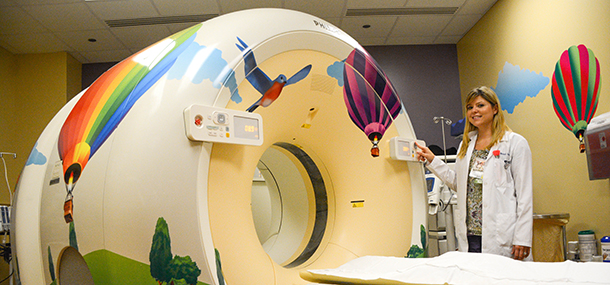
It can be a scary experience walking your child through our hospital doors. It doesn’t matter whether it’s a simple test with no IV pokes or a surgical procedure; you will always have concerns for the well being of your child. We perform many tests in Nuclear Medicine, one of which involves the insertion of a bladder catheter (which is a soft, thin tube inserted into the bladder) and is called a VCUG or cystogram. A nuclear cystogram is a test performed to identify vesicoureteral reflux (VUR, which is movement of urine from the bladder back into the ureters toward the kidneys). Your child’s pediatrician may order this test if your child has had a urinary tract infection or if a close family member such as a sibling has a history of VUR.
A cystogram takes about 20 minutes from start to finish. We understand the nature of the test is intimidating to you and your child, so you are encouraged to stay together throughout the procedure. You can also bring comfort items (such as a pacifier, bottle, blanket, stuffed animal, book, or favorite toy) for your child to have during the test. One of our child life specialists is available to offer support and coping skills through the duration of the procedure. We want to create a positive experience for you and your family while here at the hospital, so we always encourage you to let us know of any questions or concerns during your visit.
Once we are ready to start the test, your child will need to undress from the waist down. A nuclear medicine technologist will clean the opening where your child’s urine comes out and then slide a small catheter into your child’s bladder through that opening. The catheter is held in place with a piece of tape. A special medicine will then be given through the catheter to fill the bladder until your child has to urinate. Pictures will be taken by a camera under the bed during filling of the bladder and urination. If your child is potty trained, he or she can urinate while sitting on a special potty. When it is time for your child to empty their bladder, we will move the camera from under the bed to an upright position. Pictures will be taken with his or her back up against the camera. You will be able to watch the pictures during the test. Your child’s bladder will look like a round cluster of sparkles as it is getting full. We are looking for a smaller cluster of sparkles above the bladder on the right or left side, or both sides. If we see this, it would indicate your child has VUR. This test is the only way to see if VUR is present or not. If your child’s doctor wants to see the detailed anatomy (such as the bladder, ureters, and kidneys), he or she can order a similar test that is performed in the x-ray department.
Once all the pictures have been completed, the tape will be removed and the catheter will come out. You or the technologist can wipe the soap off your child with a damp wash cloth. There are no side effects from the special medicine given during this test. However, after having a catheter, your child’s urine may appear pink the first time he or she urinates. This is caused by a small amount of blood in the urine. This is normal, but if it lasts longer than 24 hours or your child has difficulty urinating, call your child’s pediatrician.
After the test, encourage your child to drink extra fluids to urinate more frequently. This will help with any irritation or burning sensations that occasionally occur after having a catheter.
The results from this procedure will be sent to your child’s doctor, usually within 24 hours. Please contact that doctor for follow-up information.
Contributed by Dr. Susan Sharp and edited by Bessie Ganim (RT-Nuclear Medicine).